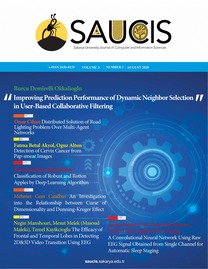Comparision of Different Machine Learning Algorithms to Predict the Diagnostic Accuracy Parameters of Celiac Serological Tests
___
[1] D. Schuppan, “Current concepts of celiac disease pathogenesis,” Gastroenterology, vol. 119, pp. 234–242, 2000.[2] S. Lohi et al, “Increasing prevalence of coeliac disease over time,” Alimentary Pharmacology &Therapeutics, vol. 26, no. 9, pp. 1217-25, 2005.
[3] M. Parizade, Y. Bujanover, B. Weiss V., Nachmias and B. Shainberg, “Performance of Serology Assays for Diagnosing Celiac Disease in a Clinical Setting,” Clinical and Vaccine Immunology, vol. 16, pp. 1576–1582, 2009.
[4] A. Fasano and C. Catassi, “Current approaches to diagnosis and treatment of celiac disease: An evolving spectrum”, Gastroenterology, vol. 120, no. 3, pp. 636-51, 2001.
[5] A. Marlou and A.D. Leffler, “Serum Markers in the Clinical Management of Celiac Disease,” Digestive Disease, vol. 33, pp. 236–243, 2015.
[6] D. Basso et al. “A new indirect chemiluminescent immunoassay to measure Anti-Tissue Transglutaminase antibodies,” J Pediatr Gastroenterol Nutr., vol. 43, pp. 613-8, 2006.
[7] P. Eusebi, “Diagnostic Accuracy Measures,” Cerebrovascular Diseases, vol.36, pp. 267–272, 2013.
[8] A. Hoyer and A. Zapf, “Studies for the Evaluation of Diagnostic Tests,” Deutsches Ärzteblatt International, vol. 18, pp. 555–60, 2021.
[9] O. Rozenberg, A. Lerner, A. Pacht, M. Grinberg, D. Reginashvili, C. Henig and M. Barak, “A new algorithm for the diagnosis of celiac disease,” Cellular & Molecular Immunology, vol. 8, pp. 146– 149, 2011.
[10] Z. Obermeyer and J. E. Emanuel, “Predicting the Future-Big Data, Machine Learning, and Clinical Medicine,” N Engl J Med, vol. 375, no.13, pp. 1216–1219, 2016.
[11] M. Saken, M. Y. Banzragch and N. Yumusak, “Impact of image segmentation techniques on celiac disease classification using scale invariant texture descriptors for standard flexible endoscopic systems,” Turkish Journal of Electrical Engineering & Computer Sciences, vol. 29, pp. 598 – 615, 2021.
[12] R. Bellazzi and B. Zupan, “Predictive data mining in clinical medicine: Current issues and guidelines,” International Journal of Medical Informatics, vol.77, pp.81–97, 2008.
[13] Y. Long, L. Wang and M. Sun, “Structure Extension of Tree-Augmented Naive Bayes,” Entropy, vol. 21, pp.721, 2019.
[14] Z. Zhang, Y. Zhao, A. Canes, D. Steinberg and O. Lyashevska, “Predictive analytics with gradient boosting in clinical medicine,” Annals of Translational Medicine, vol. 7, no.7, pp.152, 2019.
[15] M. Song, H. Jung, S. Lee, D. Kim, and M. Ahn, “Diagnostic Classification and Biomarker Identification of Alzheimer’s Disease with Random Forest Algorithm,” Brain Sciences, vol. 11, no. 4, pp. 453, 2021.
[16] A. W. Warr, “Scientific workflow systems: Pipeline Pilot and KNIME,” J Comput Aided Mol Des., vol. 26, no.4, pp. 801–804, 2012.
[17] Y. Yuan and R. Little, “Meta-Analysis of Studies with Missing Data,” Biometrics, vol.65, pp. 487-496, 2009.
[18] J. M. Schauer, K. Diaz, T.D. Pigott and J. Lee, “Exploratory Analyses for Missing Data in MetaAnalyses and Meta-Regression: A Tutorial,” Alcohol and Alcoholism, vol. 57, pp. 35-36, 2022.
- ISSN: 2636-8129
- Yayın Aralığı: Yılda 3 Sayı
- Başlangıç: 2018
Calculation of Driving Parameters for GOA4 Signaling System using Machine Learning Methods
Mehmet Taciddin AKÇAY, Abdurrahim AKGUNDOGDU
Classification of Imbalanced Offensive Dataset – Sentence Generation for Minority Class with LSTM
Performance Analysis of Chaotic Neural Network and Chaotic Cat Map Based Image Encryption
Terrorism in Cyberspace : A Critical Review of Dark Web Studies under the Terrorism Landscape
Eda SÖNMEZ, Keziban SEÇKİN CODAL
A Novel Hybrid Binary Farmland Fertility Algorithm with Naïve Bayes for Diagnosis of Heart Disease
